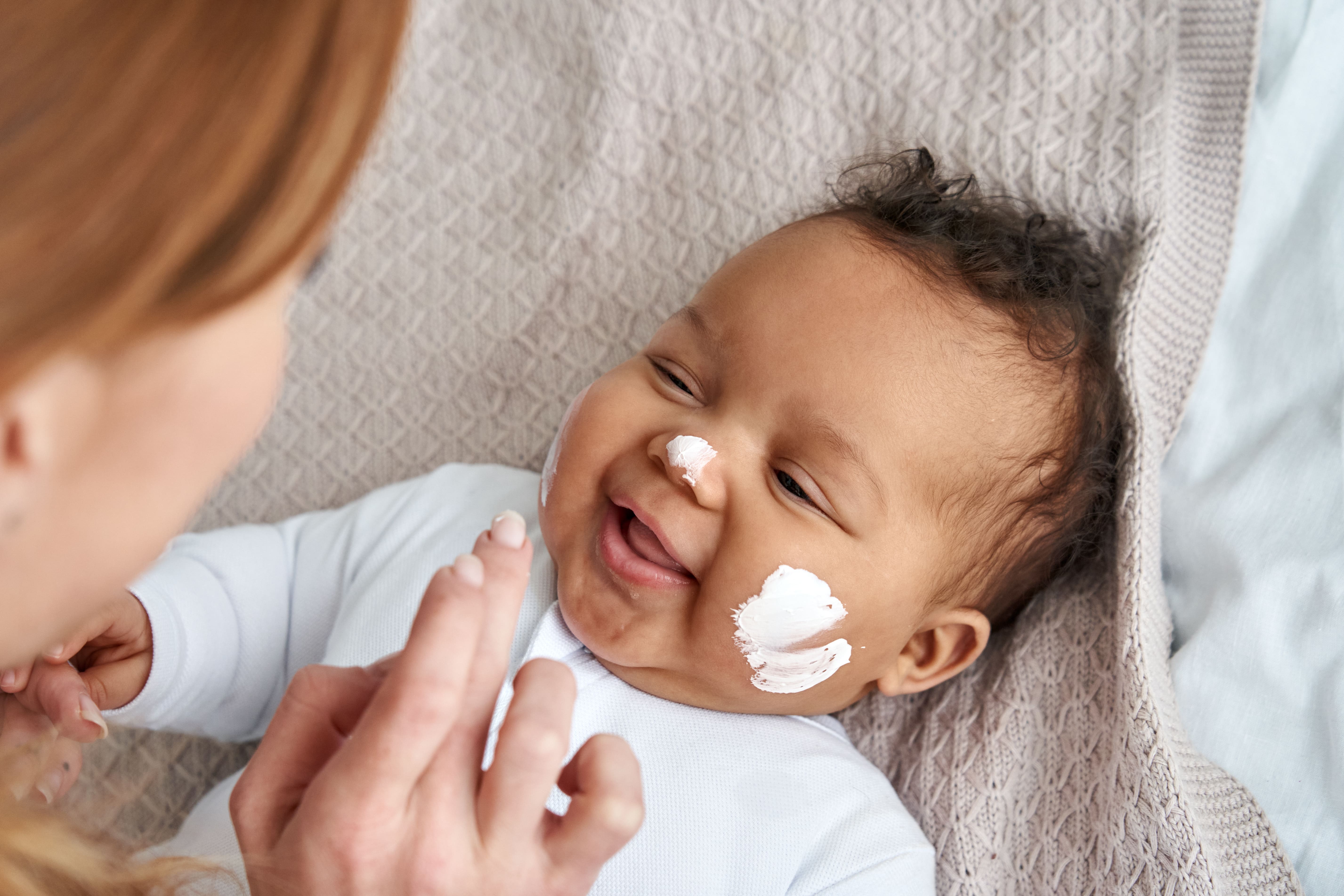Eczema, or atopic dermatitis, is a chronic skin disease that affects many children, especially infants and babies. This condition is characterized by intense itching, redness, and dry skin that can significantly impact your child's quality of life (waking up at night from scratching).
If you are looking for effective solutions to relieve your child's eczema , you have come to the right place.
In this article, we'll explore seven practical and effective solutions recommended by dermatologists and pediatric experts for managing eczema symptoms in children.
Atopic skin is a complex condition that alternates between flare-ups of eczema and periods of relief. Symptoms include inflamed, red patches, itchy skin, and dry, scaly, sensitive skin.
It's important to understand that atopy is a chronic condition that requires long-term management. The advice and treatments we offer here aim to calm eczema flare-ups, prevent new flare-ups, and improve your child's skin barrier.
With the right care and treatment, it's possible to relieve symptoms and make your child's life more comfortable. Here's how you can start caring for the skin of your baby or child affected by this condition.
1. Bathing and cleaning
Bathing and cleansing are important steps in managing atopy in children. It is essential to adopt practices that protect and soothe your child's sensitive skin.
Cleansing is essential for atopic skin to remove sweat, impurities, and allergens that can aggravate irritation. However, there are a few precautions to consider.
Use mild soap-free products
When bathing or showering, it's essential to use cleansing products specifically designed for atopic skin. Avoid traditional soaps, as they are too harsh and can alter the skin's natural pH, which is around 5.5. Soaps generally have a higher pH, which can exacerbate skin dryness and irritation. Opt for soap-free dermatological gels or bars, which respect the skin's protective hydrolipidic film.
These products should be free of allergenic preservatives such as MIT or MI/MCI blends, which are often found in shampoos. Essential oils, although natural, can also be irritating and should be avoided. For facial cleansing, use a suitable cleansing product, such as Doucea Micellar Water with prebiotics and probiotics, which will create a protective film.
Use soft, reusable bamboo fiber cotton pads to remove excess product.
Water temperature and bath duration
Water temperature and bath duration are also important factors to consider. The water should be neither too hot nor too cold.
A temperature between 35 and 37°C is ideal for baths, and around 27 to 30°C for showers. Higher temperatures can make skin drier and reactivate inflammation.
Limit baths to about 10 minutes and showers to no more than 5 minutes. Prolonged exposure to water, even lukewarm water, can dry out the skin and worsen eczema symptoms.
Additionally, water often contains chlorine and limescale, which are harmful to atopic skin. Finally, you may want to add a bath oil specially designed for atopic skin to protect the skin from the drying effects of bathing and provide the necessary lipids to nourish and soothe it.
2. Skin hydration
Moisturizing the skin is the second important step in managing atopic eczema in children. This practice helps restore the skin barrier, reduce itching, and prevent superinfection .
Selection of moisturizing creams and lotions
Choosing the right moisturizer is essential for atopic skin. It is recommended to use fragrance-free emollient creams or lotions , specifically designed for sensitive or eczematous skin. These products should be rich in fatty substances (lipids) to nourish and protect the skin.
Available textures vary, from milk to cream, balm, or spray, allowing you to choose the product best suited to the dryness and comfort of your child's skin. For very dry skin, especially in winter, a highly nourishing balm is often the most appropriate. However, for warmer periods, a lighter, more fluid texture such as a milk or spray may be more suitable.
It is also important to select sterile products without preservatives if your child has allergies.
Tips for selection:
-
Consult your doctor, pharmacist or nurse to find the product that is best suited to your child's skin.
-
Avoid products containing essential oils, which can be irritating to atopic skin.
-
Choose hypoallergenic products to minimize the risk of further skin reactions.
Frequency and key moments for hydration
Moisturizing should be a daily routine for children with atopic eczema. Here are some tips to optimize this practice:
After bathing or showering
-
Apply moisturizer immediately after bathing or showering, while skin is still slightly damp. This facilitates absorption of the product and strengthens the skin barrier. Frequency of application
-
Apply moisturizer once or twice a day, as recommended by your doctor. It's important to maintain this routine even during periods of calm to space out eczema flare-ups. Application technique
-
Spread the product between your hands before applying it to the skin in broad circular motions. For the face, apply gently with your fingertips. Avoid rubbing the skin to avoid irritation. By incorporating these practices into your child's daily routine, you significantly contribute to improving the health and comfort of their skin.
3. Environmental management
Limit common irritants
It's essential to limit your child's exposure to common irritants that can trigger or worsen eczema flare-ups. Here are some steps you can take:
Avoid dust mites and dust, which are common allergens. Ventilate your home regularly, especially in the morning and evening, to minimize the accumulation of dust and mites. Avoid rugs and carpets in bedrooms, and use a vacuum cleaner equipped with a HEPA filter to capture fine particles. Wash sheets and pillows at at least 55°C every week.
Pets can also be a source of irritation. Be sure to bathe them regularly and keep them out of your child's room to prevent their fur from contaminating the environment.
Household products and air fresheners should be used with caution. Choose fragrance-free and hypoallergenic products to avoid further irritation. Wear gloves when cleaning to protect your hands from irritants.
Controlling temperature and humidity at home
Controlling temperature and humidity at home is essential for maintaining healthy skin and preventing eczema flare-ups.
Avoid overheating your home, especially your child's bedroom. A moderate temperature between 18 and 22°C is ideal.
If the air is too dry, use a humidifier to maintain an appropriate humidity level, typically between 40 and 60 percent. This will help prevent dry skin and soothe itching. In winter, when the air is particularly dry, it's important to maintain proper skin and environmental hydration. Avoid drying environments and use methods to maintain humidity, such as a humidifier, to protect your child's skin.
In summary, careful environmental management can significantly improve the comfort and health of your child's skin with atopic eczema.
4. Appropriate clothing
Your child's clothing plays an important role in managing atopic eczema. Choices of fabrics and styles can significantly influence comfort and skin health.
Choosing fabrics and advice for clothing
It is essential to select fabrics that are soft, breathable, and non-irritating to your child's skin. Here are some tips to follow:
Choose natural, comfortable materials like cotton , linen, silk, and hemp. These fabrics have fine fibers that allow air to pass through and are less likely to cause irritation. Avoid synthetic materials like polyester or acrylic, as they don't allow the skin to breathe and can accumulate sweat, worsening eczema symptoms.
Choose loose-fitting clothing that doesn't cling to your skin, allowing for better air circulation and reducing perspiration. In winter, wear layers to maintain a comfortable temperature without overheating.
Avoid aggravating factors such as irritating labels and seams
Besides choosing the fabric, it is also important to consider other factors that can irritate the skin.
Tight clothing, turtlenecks, or tight-fitting cuts should be avoided as they can rub against the skin and cause itching. Choose clothing with loose cuts and no itchy tags or seams .
If necessary, cover the seams with silk to make them less irritating. Seamless pajamas made of soft materials like cotton or silk are ideal for nighttime wear, as they minimize irritation and provide optimal comfort.
Finally, be sure to wash new clothes before wearing them to remove any chemicals or perfumes that may be present. Use hypoallergenic detergents that are fragrance-free and fabric softener-free to minimize the risk of irritation.
5. Itch control
Itching is one of the most debilitating symptoms of atopic eczema in children. Controlling this itching is essential to improve your child's comfort and quality of life.
Use of specific anti-itch creams
To relieve itching, several types of creams and treatments can be used:
Topical corticosteroids are highly effective topical anti-inflammatory treatments for reducing eczema symptoms, including itching. They should be applied as directed by your doctor, usually once or twice a day, directly to the affected areas until the patches disappear.
Emollients are also important for maintaining skin moisture and reducing dryness, which is often the cause of itching. Apply these moisturizers several times a day, especially after bathing or showering, to slightly damp skin.
For cases of intense itching, antihistamines may be prescribed, particularly in syrup or pill form, to help relieve itching and promote sleep. However, their effectiveness is modest and they should be used with caution, especially in infants, due to possible adverse effects.
The reluctance of some parents, dermatologists and pediatricians to prescribe or use dermo-corticosteroids (topical corticosteroids) is based on several factors, including: Fear of side effects
Topical corticosteroids are effective against skin inflammation, but their misuse can lead to adverse effects, such as:
-
Skin atrophy (thinning of the skin)
-
Local depigmentation
-
Rebound effect upon abrupt cessation of treatment
-
Skin dependence in some cases of prolonged use
There is a natural alternative to corticosteroids: the use of Centella Asiatica, whose key ingredient, madecassoside, has been proven to relieve atopy and skin inflammation. This plant-based active ingredient is known for its soothing, restorative, and anti-inflammatory properties, helping to calm redness, irritation, and discomfort. By strengthening the skin barrier and promoting skin regeneration, it provides a gentle and effective solution for sensitive and atopic skin, while limiting the side effects associated with conventional treatments.
You will find it in Doutopia creams, specially formulated to meet the needs of fragile skin prone to irritation.
Behavioral methods to reduce scratching
Using thermal water: Prolonged sprays or compresses soaked in thermal water can soothe itching . Then, moisturize the skin with an emollient to maximize the effect.
The power of cold: Cold can temporarily numb itching. You can spray it with chilled thermal water from the refrigerator, use a cold pack wrapped in a thin cloth, or massage the itchy areas with smooth, chilled pebbles.
Wear gloves: Wearing cotton gloves at night can prevent your child from unconsciously scratching while they sleep. This reduces the risk of scratching and secondary infections. Use a massage roller: A massage roller can soothe itching without scratching.
Use it through clothing to avoid direct contact with skin. Trim nails short: Keeping nails short is essential to avoid scratching during scratching episodes.
This is an important habit for children with eczema. By incorporating these methods into your child's daily routine, you can significantly reduce itching and improve their comfort.
6. Food and allergies
Diet plays a significant role in managing atopic eczema in children, particularly by identifying and managing potential dietary triggers. Here's how to approach this topic effectively.
Identifying possible food triggers
Certain foods can worsen atopic eczema symptoms or even trigger flare-ups. It's important to identify these triggers so you can adjust your child's diet accordingly.
Foods most commonly associated with eczema flare-ups include cow's milk, eggs, soy, and wheat . These foods have been identified as potential triggers in children with atopic dermatitis. It is also important to limit acid-forming foods, fast-acting sugars, and saturated fats, as they can increase inflammation and impair the skin barrier.
Pesticides and endocrine disruptors found in certain foods should also be avoided to minimize their impact on hormones and overall health. On the other hand, foods rich in omega-3s, such as oily fish (sardines, mackerel, herring), vegetable oils (rapeseed, olive), berries, and green vegetables, have anti-inflammatory and antioxidant properties that can help reduce eczema symptoms.
Consultation with an allergist or dietitian
Consulting an allergist or dietitian is essential to determine specific foods that may aggravate your child's eczema and to develop a suitable meal plan.
An allergy assessment can help identify specific food allergens that trigger or worsen eczema symptoms. Based on these results, an elimination diet may be recommended to exclude problematic foods from your child's diet. A dietitian can also help you create a balanced and diverse meal plan, incorporating anti-inflammatory foods and avoiding those that are likely to cause problems.
It is important to note that dietary diversification, even in children at risk of atopic development, should be done gradually and in a varied manner, introducing foods with high allergenic potential such as eggs, soy and cereals containing gluten between 4 and 6 months. Finally, it is important not to adopt restrictive diets without medical advice, as this could deprive the body of essential nutrients and increase the risk of developing additional food allergies.
7. Medical monitoring and specific treatments

Regular medical monitoring and specific treatments are essential for effectively managing atopic eczema in children. Here's why and how these aspects are important.
The importance of regular dermatological monitoring
Regular dermatological monitoring is vital to maintain your child's skin health and adjust treatments as the disease progresses. Here are some key points to consider:
A consultation with a general practitioner, pediatrician, or dermatologist can help diagnose atopic eczema and develop a tailored treatment plan. Additional testing is generally unnecessary, but regular monitoring helps adjust treatments and prevent complications.
Regular monitoring also helps monitor your child's growth and development, as atopic eczema can affect sleep and appetite, which can impact growth charts. Careful monitoring of growth charts is essential to detect any abnormalities early.
Additionally, regular monitoring helps identify triggers and aggravators of eczema, such as food allergies or environmental irritants, and implement appropriate preventative measures.
Conclusion
Atopic eczema in children is a complex and chronic condition that requires a comprehensive and careful approach. To relieve symptoms and reduce flare-ups, it's important to maintain well-hydrated skin using appropriate creams and lotions, follow gentle bathing and cleansing routines, and manage the environment to minimize irritants. Proper dressing, itch control, and a balanced diet are also essential.
Regular follow-up with a dermatologist or pediatrician is vital for adjusting treatments and preventing complications. Topical treatments, such as topical corticosteroids and emollients, should be used according to medical recommendations. Finally, being aware of triggers and advanced treatment options can significantly improve your child's quality of life.
Don't hesitate to consult a healthcare professional for personalized advice and to develop a suitable treatment plan. By proactively caring for your child's skin and following these tips, you can help reduce the symptoms of atopic eczema and provide greater comfort for your child.
















